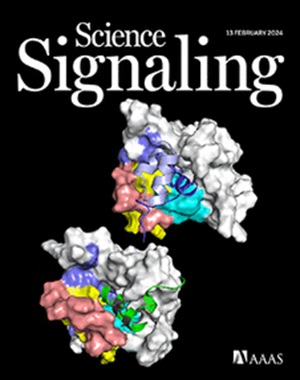胰淀素受体亚单位相互作用由激动剂调节并决定信号传导
IF 6.6
1区 生物学
Q1 BIOCHEMISTRY & MOLECULAR BIOLOGY
引用次数: 0
摘要
三种amylin受体(AMYRs)介导肽激素amylin的代谢作用,是糖尿病和肥胖症的药物靶点。AMY1R、AMY2R和AMY3R是由降钙素受体(CTR)组成的异源二聚体,CTR是一种G蛋白偶联受体,分别与RAMP1、RAMP2或RAMP3辅助亚基配对,可以增加胰淀粉酶的效力。在这里,我们发现amyr具有不同的基础亚基平衡,由肽激动剂调节,并决定了受体激活下游cAMP信号的程度。通过开发一种生化分析来分辨AMYR异源二聚体和游离亚基,我们发现AMY1R和AMY2R亚基分布有利于游离CTR和RAMPs,大鼠amylin促进AMY1R和AMY2R组成亚基的关联。激动剂α - cgrp也能诱导AMY1R亚基关联。CTR和RAMP3跨膜结构域之间更强的相互作用产生了更稳定的AMY3R,人和鲑鱼降钙素激动剂促进了AMY3R的解离。在活细胞膜中观察到亚基结合和解离的类似变化,G蛋白偶联和cAMP信号分析显示了这些变化如何改变信号传导。我们的研究结果对AMYR生物学和药物开发具有重要意义,并揭示了通过亚基相互作用动力学调控异质GPCR信号传导。本文章由计算机程序翻译,如有差异,请以英文原文为准。
Amylin receptor subunit interactions are modulated by agonists and determine signaling
Three amylin receptors (AMYRs) mediate the metabolic actions of the peptide hormone amylin and are drug targets for diabetes and obesity. AMY1R, AMY2R, and AMY3R are heterodimers consisting of the calcitonin receptor (CTR), a G protein–coupled receptor, paired with a RAMP1, RAMP2, or RAMP3 accessory subunit, respectively, which increases amylin potency. Here, we found that the AMYRs had distinct basal subunit equilibria that were modulated by peptide agonists and determined the extent of cAMP signaling downstream of receptor activation. By developing a biochemical assay that resolves the AMYR heterodimers and free subunits, we found that the AMY1R and AMY2R subunit distributions favored free CTR and RAMPs and that rat amylin promoted association of the constituent subunits of AMY1R and AMY2R. The agonist αCGRP also induced AMY1R subunit association. A stronger interaction between the CTR and the RAMP3 transmembrane domains yielded a more stable AMY3R, and human and salmon calcitonin agonists promoted AMY3R dissociation. Similar changes in subunit association and dissociation were observed in live-cell membranes, and G protein coupling and cAMP signaling assays showed how these changes altered signaling. Our findings have implications for AMYR biology and drug development and reveal regulation of heteromeric GPCR signaling through subunit interaction dynamics.
求助全文
通过发布文献求助,成功后即可免费获取论文全文。
去求助
来源期刊

Science Signaling
BIOCHEMISTRY & MOLECULAR BIOLOGY-CELL BIOLOGY
CiteScore
9.50
自引率
0.00%
发文量
148
审稿时长
3-8 weeks
期刊介绍:
"Science Signaling" is a reputable, peer-reviewed journal dedicated to the exploration of cell communication mechanisms, offering a comprehensive view of the intricate processes that govern cellular regulation. This journal, published weekly online by the American Association for the Advancement of Science (AAAS), is a go-to resource for the latest research in cell signaling and its various facets.
The journal's scope encompasses a broad range of topics, including the study of signaling networks, synthetic biology, systems biology, and the application of these findings in drug discovery. It also delves into the computational and modeling aspects of regulatory pathways, providing insights into how cells communicate and respond to their environment.
In addition to publishing full-length articles that report on groundbreaking research, "Science Signaling" also features reviews that synthesize current knowledge in the field, focus articles that highlight specific areas of interest, and editor-written highlights that draw attention to particularly significant studies. This mix of content ensures that the journal serves as a valuable resource for both researchers and professionals looking to stay abreast of the latest advancements in cell communication science.
 求助内容:
求助内容: 应助结果提醒方式:
应助结果提醒方式:


